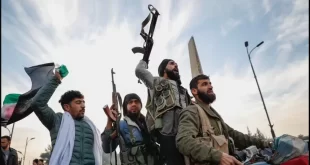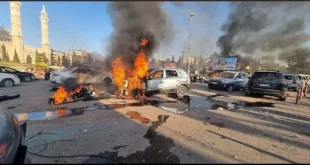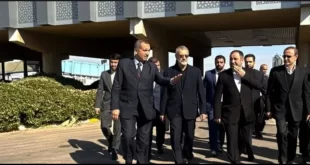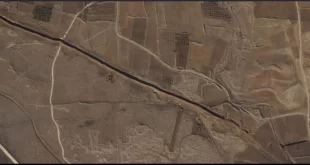Sep, 2013, Greg Shupak
Liberal interventionists thought they had this one. Their doctrine had seemingly triumphed in Libya. Not only were the usual suspects, the Christopher Hitchenses, the Bernard-Henri Levys, peddling the notion that NATO could be a global constabulary for the enforcement of human rights, but more careful commentators like Juan Cole and Gilbert Achcar had also backed Western intervention. If NATO’s war in Libya has now lost some of its initial luster, it is primarily because the murder of US Ambassador to Libya Christopher Stevens and three other Americans brought worldwide attention to the nature of the forces the war unleashed and to the chaotic state in which Libyans now find themselves.
But the shine was, from the start, an illusion, as Maximilian Forte proves in his important new book, Slouching Towards Sirte. Forte thoroughly chronicles NATO’s bombing of Libya and the crimes against humanity for which NATO is responsible. The author takes us on a tour of Sirte after it had been subject to intense NATO bombardment by chronicling journalists’ impressions of the city in October 2011. Reporters observed, “Nothing could survive in here for very long,” that the city was “reduced to rubble, a ghost town filled with the stench of death and where bodies litter the streets,” that it was a place “almost without an intact building,” whose infrastructure “simply ceased to exist,” and resembled “Ypres in 1915, or Grozny in 1995,” or postwar “Leningrad, Gaza or Beirut.”
Forte describes numerous NATO operations which, he argues, rose to the level of war crimes. For example, he discusses a NATO strike on a farming compound in the town of Majer on 8 August 2011. A Human Rights Watch investigation concluded that NATO fired on the compound twice, the second time killing 34 civilians who had come to look for survivors —a tactic familiar to those who follow US drone strikes in Pakistan and Yemen—and found no evidence that the target had been used for military purposes. In its examination of five sites where NATO caused civilian casualties, the UN Human Rights Council (UNHRC) found that at four of those sites NATO’s characterization of the targets as “‘command and control nodes’ or ‘troop staging areas’ was not reflected in evidence at the scene and witness testimony.” In view of these and other killings of civilians by NATO, Palestinian lawyer Raji Sourani remarks that the Independent Civil Society Mission to Libya of which he was a part has “reason to think that there were some war crimes perpetrated” by NATO. Through this method, Forte shows the fundamental contradiction of humanitarian wars: they kill people to ensure that people are not killed.
Racist Rebels
One lesson liberal interventionists should draw from the Libyan war is that the mere fact of opposing a tyrant does not indicate that a given rebel group values human rights. Forte persuasively demonstrates that the thuwar – the anti-Qadhafi fighters – had no such standards. On October 21 2011, 66 bodies were found at the Mahari Hotel, at least 53 of whom were executed by a rebel militia. An undetermined portion of these were Qadhafi loyalists who had been captured along with Qadhafi himself. Those killed at the hotel were shot with rifles and many had their hands tied behind their backs and some can be seen on video being abused before their execution. NATO plainly shares responsibility for these crimes because before NATO bombing commenced, the insurgents were on the verge of defeat and could not have won the war without NATO air cover, arms, money, and diplomatic support.
The most serious indictment of NATO’s rebel allies is their violent treatment of black Libyans and migrant workers from countries in southern Africa. For instance, when Tripoli fell to rebels in August 2011, a reporter for The Independent visited a makeshift hospital controlled by the insurgents and found the decomposing bodies of 30 men, many of whom had their hands bound behind their backs and almost all of whom were black. Hostility towards these groups has its origin in the rumor that Qadhafi employed large numbers of mercenaries from southern Africa, a notion popularized early in the rebellion, and spread throughout Western media and the pro-intervention Al-Jazeera English. On this aspect of the war Forte quotes Jean Ping, chair of the African Union, as saying that the “NTC seems to confuse black people with mercenaries….They are killing people, normal workers, mistreating them.”
Other evidence confirms Forte’s account. For example, an Amnesty International report notes that the rebels “have ‘arrested’” many suspected African mercenaries “although such ‘arrests’ are better described as abductions.” The UNHRC report notes, “From the beginning of the uprising in February 2011, dark-skinned migrant workers were targeted – including being killed” [sic]. It appears no mercenaries were used by Qadhafi, and even if he had used such fighters, it would not justify widespread discriminatory practices or pigment-based violent attacks. In any case, as Forte points out, executing captured mercenaries is prohibited by international law.
Forte pays particular attention to the experience of the black residents of Tawergha, a town adjoining Misrata. Insurgents from Misrata depopulated Tawergha of virtually all of its 10,000-30,000 predominantly black residents and looted and vandalized their homes. The officer in charge of the rebel garrison in the town said, “We gave [the Tawergha] thirty days to leave. We said if they didn’t go, they would be conquered and imprisoned. Every single one of them has left, and we will never allow them to come back.” The UNHRC supports Forte’s account. It found that “thuwar have extra-judicially executed, otherwise unlawfully killed and tortured to death Tawerghans,” that they have “arbitrarily arrested Tawerghans in locations across Libya,” that “the continuing destruction of Tawergha in the post-conflict period has been done with the intent of . . . preventing the return of displaced Tawerghans,” that these activities constitute “a war crime” and that “the facts indicate crimes against humanity have taken place.”
A Propaganda Campaign
To the extent that the enduring conservative justification for militarism is that every world leader opposed to Western interests is another Hitler, the equivalent for liberal interventionists is the notion that any party to a conflict that they both side with, and deem likely to lose, are the next Rwandan Tutsis. The latter group is cast as an innocent, helpless and defenceless people who can only be saved by the might of benevolent and disinterested Western militaries. Thus the residents of Benghazi were put forth as the Tutsis in the Western imaginary – a claim with little basis in fact.
Hysterical claims that Qadhafi was on the verge of carrying out a genocide rang out in the Western press. However, these had little basis. Forte quotes Alan J. Kuperman, noting that, “The best evidence that Khadafy did not plan genocide in Benghazi is that he did not perpetrate it in the other cities he had recaptured either fully or partially — including Zawiya, Misurata, and Ajdabiya.” During his 42 year rule, Qadhafi faced numerous coup attempts and armed revolts. Though he typically dealt with the alleged perpetrators in a brutal fashion, at no point did his regime behave in a genocidal manner.
Furthermore, the ground for instituting a no-fly zone over Libya through UN Security Council Resolution 1973 was the assertion that Qadhafi was bombing protestors from the sky. Yet, as Forte demonstrates, US Secretary of Defense Robert Gates said that he had no confirmation that Qadhafi fired on Libyans from the air. Similarly, Al-Jazeera English, US Ambassador to the UN Susan Rice, and then-Secretary of State Hilary Clinton circulated the claim that Qadhafi had fed his military Viagra so as to facilitate mass rape. While it is clear that Qadhafi’s forces committed acts of sexual violence, Forte draws on Amnesty International and other sources to demonstrate that the dissemination of Viagra no more took place than did the Iraqi military’s killing of babies in Kuwaiti incubators in 1991.
The Legitimacy of Political Violence
Underlying Forte’s accounts of the use of force are vital questions about the legitimacy of political violence. Forte rightly questions why the “international community” permits NATO to carry out a brutal counter-insurgency that is designed to keep Afghan President Hamid Karzai’s undemocratic regime in power instead of a ruthless insurgency but is indignant at the prospect of Qadhafi’s undemocratic regime doing the same to keep itself in power and ward off a ruthless insurgency. Liberal interventionists apparently believe that all violence enacted by NATO militaries or anyone on their side is legitimate, whereas the opposite is true for the violence of NATO’s antagonists. Part of what’s at play here is the question of how social change takes place. Even in view of the troubles of “democracy” imposition in Afghanistan and Iraq, the liberal interventionists seem to assume that the best way that dark-skinned peoples in the global South can achieve “freedom” is under the tutelage of NATO bombs: “This is a bleak vision of humanity that has been erected by the ‘humanitarians,’” as Forte writes, “one at odds with history, sociology, and anthropology, which are rich with countless cases of people who have been able to fight, resist, and practice multiple forms of self-protection; indeed, local actors struggling for change often prefer their own solutions over those imposed by outsiders.”
Yet, on the question of the legitimacy of political violence, one could argue that Forte at times ensnares himself in a parallel trap. Hostile readers of his book may come away with the impression that Forte believes Libyans had no right to undertake armed struggle against Qadhafi’s dictatorship under any circumstances – or perhaps even that he views the very idea of a Libyan uprising as something that is, even apart from NATO involvement, to be opposed. What is needed is for debates about the legitimacy of political violence and intervention to be based on a consistent application of coherent principles and scrupulous attention to the particular details of each conflict, for there are no simple, one-size-fits-all answers to questions about the legitimacy of the use of political violence. And while in the early stages of the Libyan conflict there was no guarantee that a protracted war would solve the issues under contestation, it should have been clear to any observer that prolonging combat would displace, kill and maim large numbers of civilians and destroy infrastructure.
For these reasons, the right position on the situation faced by Libyans in February-March 2011 would have been to seek the earliest possible end to armed hostilities. Ample opportunities for a negotiated settlement to the Libyan conflict existed, and Forte shows how NATO and its allies scuttled all attempts to facilitate a peaceful solution to the war. Qadhafi’s five ceasefire offers were rejected out of hand, including one that was offered hours after the passage of UN Resolution 1973 authorized the use of “all necessary measures” to protect civilians. The African Union’s (AU) attempt at facilitating a ceasefire and negotiations in April was obstructed by NATO and its allies and in June a derivative of this plan was put forth by US Congressman Dennis Kucinich, who later revealed that a peaceful settlement was on the verge of realization but officials in the US State Department deliberately de-railed it.
African Contexts
The blockage of the AU plan is crucial because it offers some insight into the question of why the West fought its war in the Jamahiriya. As Forte’s book clarifies, NATO’s war in Libya was at least in part a war for power and control in Africa, one which has hastened the militarization of the continent. At the centre of what Forte calls a “new scramble for Africa” is the United States’ Africa Command (AFRICOM), an organization based in Germany, and in charge of US military relations with 53 African states. The Qadhafi regime’s opposition to AFRICOM is a context in which NATO’s decision to intervene on the side of anti-Qadhafi forces must be understood. Citing cables from the US embassy in Tripoli, Forte documents American frustration with African governments, “mostly notably…Libya,” who prevented the U.S from establishing a base for AFRICOM operations in Africa and who viewed AFRICOM as a vehicle for “latter-day colonialism.” While the organization claims that its command is “indirect” and that it will collaborate with civilian agencies, Forte quotes AFRICOM commander General Ham as saying that this “does not mean we simply wait for others to ask for our support. I expect our Command to actively seek and propose innovative and imaginative approaches through which we may apply the considerable military capability of the United States to its best advantage.”
The rise and fall of the Community of Sahel-Saharan States (CEN-SAD) is another key context. CEN-SAD is a Tripoli-Based regional body, formed in 1998 to promote trade, free movement, telecommunications, and security among its member countries. The organization, which included approximately half of the population and territory of Africa, was a building block of and a source of competition with the AU. Under Qadhafi, Libya was a major player in CEN-SAD as shown by the country’s launching and funding of the Sahel-Saharan Bank for Investment and Commerce (BSIC) and its establishing the Fund for Assistance and Support to Women, Children and Youths. In 2007, CEN-SAD issued a statement “categorically rejecting” AFRICOM and any foreign military presence in any member state. Because of this, US officials were irritated by CEN-SAD, and misrepresented it as a solely Libyan organization. What CEN-SAD represented was an organization of African states that collectively had the potential to curtail US influence and to chart an independent path for much of the continent.
In view of this, it will come as no surprise that in the month of Qadhafi’s murder, the U.S announced it was sending troops to the Central African Republic, Uganda, South Sudan, and the Democratic Republic of Congo. With Qadhafi’s regime gone, AFRICOM announced before Libya could have an election that a new military relationship had been established between AFRICOM and a post-Qadhafi Libyan government that was appointed by the NTC. Furthermore, the U.S established an Office of Security Cooperation at the U.S Embassy in Tripoli to “help coordinate security assistance, international military education and training and other security cooperation.” CEN-SAD, meanwhile, is all but defunct.
Another key background point to the war on Libya is China’s ongoing competition with Western interests for access and influence in Africa. In 2009, China surpassed the U.S. as Africa’s largest trading partner. The continent supplied China with a third of its imports and was its second largest source of oil. Africa is a continent rich with not only oil but also strategic minerals. The U.S is heavily import-dependent on materials such as columbium, chromium, and cobalt for its weapons manufacturing. Mozambique, South Africa, Zimbabwe, and Congo are major sources of these. Consider in this context Forte’s account of the African Oil Policy Initiative Group, an organization involving Congressional representatives, oil industry lobbyists, and members of the military. As far back as 2002, this group was calling for an increased American military presence in Africa as a means of securing control of resources, and it identified China and Libya as barriers to this goal.
As NATO’s war in Libyan played out, it was primarily understood within two narratives – a humanitarian one, as well as that of the so-called Arab Spring. Both conceptions suffer from their lack of understanding of the war’s African contexts, which suggest that the continent is at risk of again becoming a global hotspot over which foreign powers battle. Self-described humanitarians would do well to consider how their advocacy of the Libyan campaign not only caused extensive death and human rights violations but
 Syria Support Movement solidarity with the Syrian people
Syria Support Movement solidarity with the Syrian people





